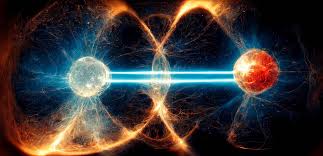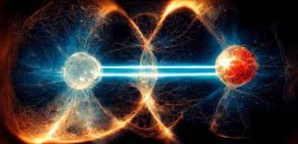The world is getting closer to realising the ideal of clean, endless power with the recent experiment that produced more energy than any previous nuclear fusion experiment.
The JET laboratory in the United Kingdom has established a new world record. Stars are powered by a process called nuclear fusion. It might provide enormous amounts of energy without warming our environment, according to scientists.
"We have achieved things we've never done before," stated the European experts working at the site. After more than 40 years of fusion research, the lab's final experiment produced the outcome.
UK Minister for Nuclear Affairs Andrew Bowie described it as a "fitting swansong".
What is the breakthrough in nuclear fusion and how does it operate?
The Sun is powered by a process known as nuclear fusion. It produces useful energy by heating and compressing small particles into a larger one.
It has the potential to generate unlimited amounts of renewable energy devoid of carbon emissions if it is properly scaled up to commercial levels. Most importantly, unlike solar and wind energy, it would not be dependent on the weather.
However, this is not simple, as Dr. Aneeqa Khan, Research Fellow in Nuclear Fusion, University of Manchester, clarified.
"In order for the atoms to fuse together on Earth, we need temperatures ten times hotter than the Sun - around 100 million celsius, and we need a high enough density of the atoms and for a long enough time," she explained.
Over the course of five seconds, the trials generated 69 megajoules of energy. That is not much energy—only enough for four or five hot baths. It is evident that nuclear fusion power plants are still a long way off, yet every experiment moves us closer to the goal.
"The new results from JET's final run are very exciting," stated Prof. Stuart Mangles, Head of Imperial College London's Space, Plasma, and Climate Research Community.
"This result really highlights the power of international collaboration, these results wouldn't have been possible without the work of hundreds of scientists and engineers from across Europe."
Until the end of last year, the Joint European Torus (JET) facility, which was built at Culham, Oxford, in the late 1970s, was the most sophisticated experimental fusion reactor in the world. December marked the end of all experiments.
Despite being headquartered in the UK, it was run by the UK Atomic Energy Agency and primarily funded by the EU's Euratom nuclear research programme. It welcomed scientists from the UK, Europe, Switzerland, and Ukraine for forty years.
The reactor was originally supposed to run for about ten years, but it ended up lasting much longer because to several accomplishments. When comparable tests were conducted back in 1997, the outcome that was revealed today was quadruple that.
"Our successful demonstration... instils greater confidence in the development of fusion energy. Beyond setting a new record, we achieved things we've never done before and deepened our understanding of fusion physics," said Prof Ambrogio Fasoli, programme manager at EUROfusion.
UK Minister for Nuclear and Networks, Andrew Bowie, said: "JET's final fusion experiment is a fitting swansong after all the ground-breaking work that has gone into the project since 1983. We are closer to fusion energy than ever before thanks to the international team of scientists and engineers in Oxfordshire," said Andrew Bowie, UK Minister for Nuclear and Networks.
However, it's unclear what part the UK will play going forward in European fusion research. The UK has not been allowed to participate in the Euratom programme since Brexit, and the government decided not to rejoin last year.
Rather than that, the government said that £650 million will go into national research initiatives.
ITER, a facility headquartered in France, is the Euratom replacement for JET. Its start-up date has been pushed back to 2025 and its price has nearly doubled from its original plans to launch in 2016 at a cost of approximately 5 billion euros. As of right present, full-scale experiments are not expected until at least 2035.
The UK government's decision not to rejoin Euratom was made without explanation, however it is thought that ITER delays had a role.
"Given delays to association and the direction of travel of these EU programmes, an alternative approach gives the UK the best opportunity to deliver our fusion strategy," a spokesman for the Department of Energy Security and Net Zero stated at the time.
Ian Chapman, of UKAEA, did mention that talks were still continuing on with European partners to see how the UK could be involved with ITER in the future during the record announcement on Thursday.
The government now plans to construct the first fusion power plant in history in Nottinghamshire, with plans to start operations there in the 2040s. Delivering the Spherical Tokamak for Energy Production (STEP) project is UK Industrial Fusion Solutions, a recently established nuclear organisation.
(Source:www.bbc.com)
The JET laboratory in the United Kingdom has established a new world record. Stars are powered by a process called nuclear fusion. It might provide enormous amounts of energy without warming our environment, according to scientists.
"We have achieved things we've never done before," stated the European experts working at the site. After more than 40 years of fusion research, the lab's final experiment produced the outcome.
UK Minister for Nuclear Affairs Andrew Bowie described it as a "fitting swansong".
What is the breakthrough in nuclear fusion and how does it operate?
The Sun is powered by a process known as nuclear fusion. It produces useful energy by heating and compressing small particles into a larger one.
It has the potential to generate unlimited amounts of renewable energy devoid of carbon emissions if it is properly scaled up to commercial levels. Most importantly, unlike solar and wind energy, it would not be dependent on the weather.
However, this is not simple, as Dr. Aneeqa Khan, Research Fellow in Nuclear Fusion, University of Manchester, clarified.
"In order for the atoms to fuse together on Earth, we need temperatures ten times hotter than the Sun - around 100 million celsius, and we need a high enough density of the atoms and for a long enough time," she explained.
Over the course of five seconds, the trials generated 69 megajoules of energy. That is not much energy—only enough for four or five hot baths. It is evident that nuclear fusion power plants are still a long way off, yet every experiment moves us closer to the goal.
"The new results from JET's final run are very exciting," stated Prof. Stuart Mangles, Head of Imperial College London's Space, Plasma, and Climate Research Community.
"This result really highlights the power of international collaboration, these results wouldn't have been possible without the work of hundreds of scientists and engineers from across Europe."
Until the end of last year, the Joint European Torus (JET) facility, which was built at Culham, Oxford, in the late 1970s, was the most sophisticated experimental fusion reactor in the world. December marked the end of all experiments.
Despite being headquartered in the UK, it was run by the UK Atomic Energy Agency and primarily funded by the EU's Euratom nuclear research programme. It welcomed scientists from the UK, Europe, Switzerland, and Ukraine for forty years.
The reactor was originally supposed to run for about ten years, but it ended up lasting much longer because to several accomplishments. When comparable tests were conducted back in 1997, the outcome that was revealed today was quadruple that.
"Our successful demonstration... instils greater confidence in the development of fusion energy. Beyond setting a new record, we achieved things we've never done before and deepened our understanding of fusion physics," said Prof Ambrogio Fasoli, programme manager at EUROfusion.
UK Minister for Nuclear and Networks, Andrew Bowie, said: "JET's final fusion experiment is a fitting swansong after all the ground-breaking work that has gone into the project since 1983. We are closer to fusion energy than ever before thanks to the international team of scientists and engineers in Oxfordshire," said Andrew Bowie, UK Minister for Nuclear and Networks.
However, it's unclear what part the UK will play going forward in European fusion research. The UK has not been allowed to participate in the Euratom programme since Brexit, and the government decided not to rejoin last year.
Rather than that, the government said that £650 million will go into national research initiatives.
ITER, a facility headquartered in France, is the Euratom replacement for JET. Its start-up date has been pushed back to 2025 and its price has nearly doubled from its original plans to launch in 2016 at a cost of approximately 5 billion euros. As of right present, full-scale experiments are not expected until at least 2035.
The UK government's decision not to rejoin Euratom was made without explanation, however it is thought that ITER delays had a role.
"Given delays to association and the direction of travel of these EU programmes, an alternative approach gives the UK the best opportunity to deliver our fusion strategy," a spokesman for the Department of Energy Security and Net Zero stated at the time.
Ian Chapman, of UKAEA, did mention that talks were still continuing on with European partners to see how the UK could be involved with ITER in the future during the record announcement on Thursday.
The government now plans to construct the first fusion power plant in history in Nottinghamshire, with plans to start operations there in the 2040s. Delivering the Spherical Tokamak for Energy Production (STEP) project is UK Industrial Fusion Solutions, a recently established nuclear organisation.
(Source:www.bbc.com)






